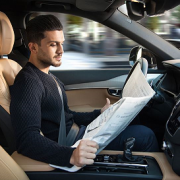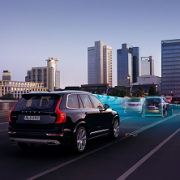British ‘What Would You Do in Your Driverless Car’ Survey Yields Unexpected Results
Jennifer van der Kleut
When South London-based logbook lender Varooma set out to find out what activities Britons would most like to do in their driverless cars once they no longer have to drive their vehicles themselves, they got some unexpected results.
Instead of giving expected answers like sleep, work or watch videos, most Britons said-they wouldn’t be in a driverless car in the first place.
A whopping 73 percent of Britons surveyed said they prefer to drive themselves over taking a driverless car.
Along the same vein, 38 percent of responders said they would not purchase a driverless car, even if they were readily available for purchase and were the same price as regular cars.
Are autonomous vehicles better suited to future generations? Varooma suggests their survey results may indicate just that. Results said that 18- to 24-year-olds would be most comfortable and “chill” engaging in other activities rather than paying attention to the road in a driverless car.
Then, after skipping a generation or so, acceptance of the idea of driverless cars gains traction again as people enter their senior years. The survey results show that people of ages 55 to 64 are more likely to want to purchase a driverless car than adults age 45 to 54.
The idea of autonomous vehicles have long been touted as a solution for aging drivers, as well as those with physical disabilities.
However, those open to the idea of driverless cars did have a few ideas of what they would like to do on their commutes if they didn’t need to pay attention to the road.
Perhaps unsurprisingly, 24 percent of men age 18-24 said they would “catch Pokemon.” Twenty-two percent said they would “catch up on sleep.”
Almost all responders said they would love to read a book or watch a movie.
Interestingly, more women said they would be a little distrusting of the technology and would probably keep one eye on the road (22.3 percent) than men (16.3 percent).
What jobs would Britons trust their car to do without them, while they were at work?
Another popular idea in regards to autonomous vehicles is the idea that your car could perform simple jobs for you while you are otherwise engaged, such as daytime work hours. So, Varooma also asked their survey takers what jobs they would feel comfortable sending their car to do while they were at work.
The number-one response from middle-aged men was “send their car to the car wash.”
The top answer from women of the same age was to send their car to pick up take-out food.
When it came to driving around their children, though, the numbers were a lot lower. Only around 4 percent of responders said they would feel comfortable having their autonomous car drive their children to school without them.
Even fewer said they would feel comfortable sending their car to deliver cash to someone-3.6 percent.
Varooma’s survey was conducted through Google consumer surveys. Their survey netted 1,591 online responses.


